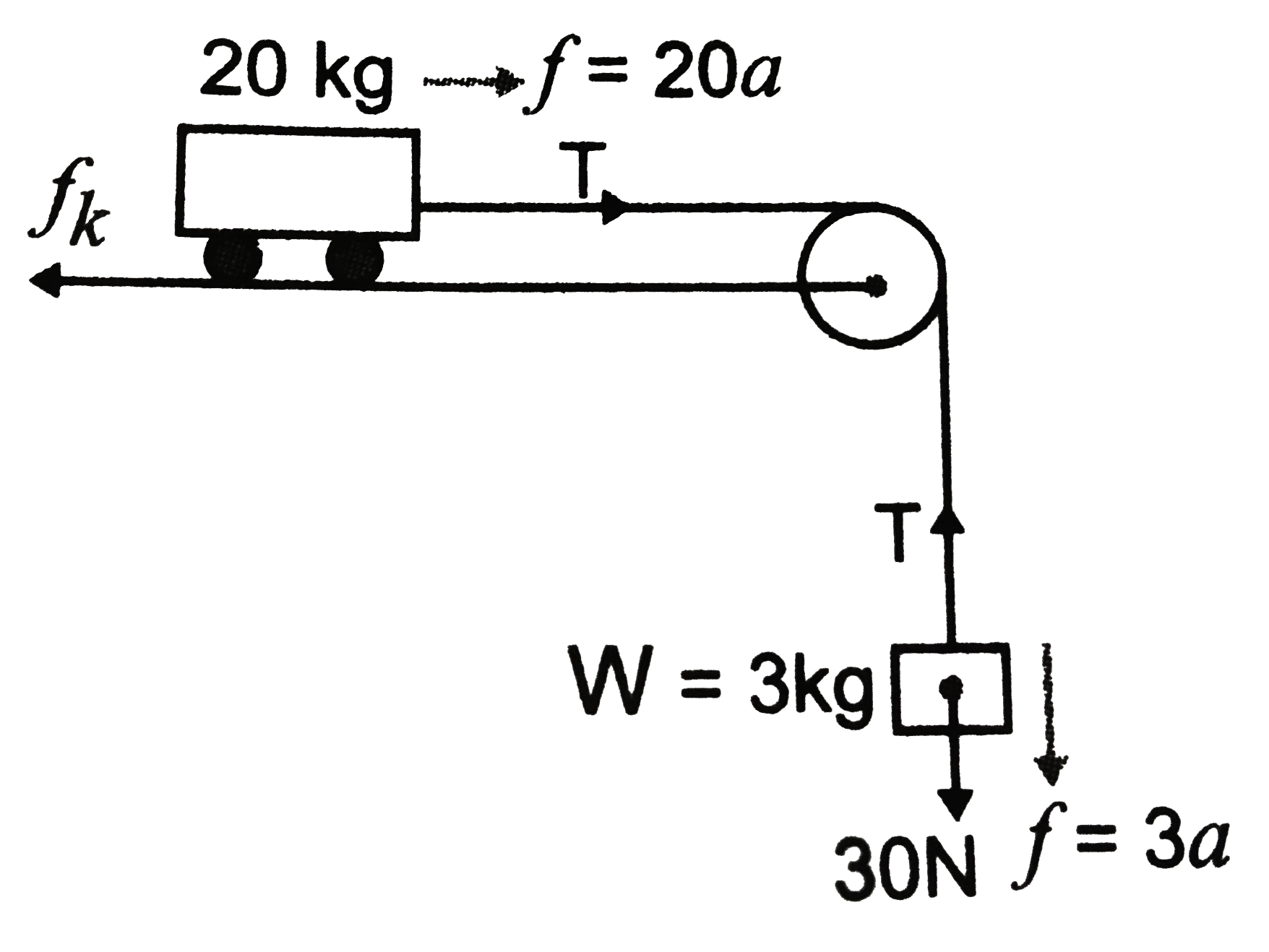A block of mass 15 kg is placed on a long trolley. The coefficient of static friction between the block and the trolley is 0.18. The trolley accelerates from rest with0.5ms−2 for 20 s and then moves with uniform velocity. Discuss the motion of the block as viewed by (a) a stationary observer on the ground, (b) an observer moving with the trolley.
(a) Maximum frictional force possible for opposing impending relative motion between the block and the trolley =150×0.18=27N, which is more than the frictional force of 15×0.5=7.5N needed to accelerate the box with the trolley. When the trolley moves with uniform velocity, there is no force of friction acting on the block.
(b) For the accelerated (non-inertial) observer, frictional force is opposed by the pseudo- force of the same magnitude, keeping the box at rest relative to the observer. When the trolley moves with uniform velocity there is no pseudo-force for the moving (inertial) observer and no friction.
Topper's Solved these Questions
- LAW OF MOTIONBOOK - NCERT BANGLISHCHAPTER - LAW OF MOTIONEXERCISE - EXERCISE
23 Videos
- KINETIC THEORYBOOK - NCERT BANGLISHCHAPTER - KINETIC THEORYEXERCISE - ADDITIONAL EXERCISE
3 Videos
- MECHANICAL PROPERTIES OF FLUIDS BOOK - NCERT BANGLISHCHAPTER - MECHANICAL PROPERTIES OF FLUIDS EXERCISE - EXERCISE
43 Videos
Similar Questions
A block of mass 15 kg is placed on a long trolley . The coefficient of friction between the block and the trolley is 0.18. The trolley accelerates from rest with 0.5ms−2 for 20s and then moves with uniform velocity. Discuss the motion of the block as viewed by (a) a stationary observer on the ground (b) as observer moving with the trolley.
View SolutionA block of mass 15 kg is placed on a long trolly . The coefficient of friction between the block and trolly is 0.18 The trolly accelerates from rest at 0.5m/s2 for 20 seconds and then moves with a unifrom velocity Discuss the motion of the block as viewed by (i) a stationary observer on the ground (ii) an observer moving with the trolly .
View Solution
Knowledge Check
A block of mass 15kg is placed on a long trolley. The cofficient of fricition between the block and trolley is 0.18. The trolley accelerates from rest with 0.5m/s2 for 20s. then what is the friction force:-
A3.5NB133.3NC7.5NDN.O.T.A block of mass 2kg is placed on the surface of trolley of mass 20kg which is on a smooth surface.The coefficient of friction between the block and the surface of the trolley is 0.25.If a horizontal force of 2N acts on the block, the acceleration of the system in ms−2 is (g=10ms−2)
A1.8B1.0C0.9D0.09
A block of mass 15 kg is placed on a long trolly . The coefficient of friction between the block and trolly is 0.18 The trolly accelerates from rest at 0.5m/s2 for 20 seconds and then moves with a unifrom velocity Discuss the motion of the block as viewed by (i) a stationary observer on the ground (ii) an observer moving with the trolly .
View SolutionA block of mass 15kg is placed on a long trolley. The cofficient of fricition between the block and trolley is 0.18. The trolley accelerates from rest with 0.5m/s2 for 20s. then what is the friction force:-
View SolutionWhat is the acceleration of the block and trolley system shown in if the coefficient of kinetic friction between the trolley and the surface is 0 .04 ? What is the tension in the string ? Take g=10ms−2 Neglect the mass of the string
 .
.
View SolutionWhat is the acceleration of the block and trolley system shown in if the coefficient of kinetic friction between the trolley and the surface is 0 .04 ? What is the tension in the string ? Take g=10ms−2 Neglect the mass of the string
 .
.
View SolutionIn Fig. 6-48, a 2.0 kg block lies on a 20 kg trolley that can roll across a floor on frictionless bearings. Between the block and the trolley, the coefficient of kinetic friction is 0.20 and the coefficient of static friction is 0.25. When a horizontal 2.0 N force is applied to the block, what are the magnitudes of (a) the frictional force between the block and the trolley and (b) the acceleration of the trolley?

View SolutionA block of mass 2kg is placed on a trolley of mass 20 kg free to move on a frictionless floor. What are the frictional force, accelerations of the block and trolley if the block is pulled by a force of 3 N ? The coefficient of friction between block and trolley is 0.25. What will be the values of all three if the block is pulled by 8 N force ? At what value of the applied force will the bodies just tend to separate ?
[Hint : So long as the force applied does not produce the limiting frictional force the two will move with common acceleration. When the force applied exceeds that limiting value the block will move on the trolley with a different acceleration]
View Solution
